柚[Citrus grandis(L.)Osbeck]又名抛子、文旦,葡萄柚(C.paradisi Macf.)又名西柚或圆柚,两者均为芸香科柑橘属植物。柚的果实柚子,果型硕大、营养丰富、耐贮藏、便于运输,有“天然罐头”之称[1];葡萄柚果实比柚子较小,口感酸甜,略带苦味,具有清热退火的功效,主要用作鲜食、果汁、罐头和色拉的原料[2]。大多学者认为葡萄柚是柚与甜橙的回交后代[3-5],在植物分类上属于与柚并列的一个种,在栽培上将其列入柚类[6]。柚类是柑橘属四大栽培种类群(宽皮柑橘类、橙类、柚类、柠檬类)之一,中国作为柚类的原产地和变异中心,有着丰富的种质资源以及数千年的栽培历史[7-9]。
植物新品种保护是实施国家知识产权和种业振兴的重要组成部分,其不仅关系到育种权人的切身利益,还对推动种业的创新和发展起到关键作用。根据《中华人民共和国种子法》规定,申请品种权保护和品种审定、登记的农作物,均需开展特异性、一致性和稳定性(DUS)测试[10]。中国于2003年将柑橘属列入中华人民共和国农业植物品种保护名录(第五批)中,并于2013年发布《植物新品种特异性、一致性和稳定性测试指南柑橘》(NY/T 2435—2013)农业行业标准(以下简称柑橘属测试指南)。该指南的适用范围包括整个柑橘属,共有113 个测试性状,含质量性状和假质量性状45 个,数量性状68 个。数量性状是指表达状态覆盖了从一个极端到另一个极端之间的整个变异范围的性状[11],如叶片长度、果实质量等。数量性状分级是数量性状代码转换的重要依据,数量性状分级科学与否直接影响测试的最终结果。由于数量性状极易受环境条件的影响,测试指南中没有规定每个数量性状的具体分级范围,通过给出相应的一套标准品种作为标尺矫正每个生长周期中外界环境对测试结果的影响。
柑橘属测试指南中列出了甜橙、宽皮橘、柚类和柠檬这四种类群的标准品种。其中,柚和葡萄柚虽同为柚类,两者体型却存在较大差异,在果型大小方面有着显著差别。但柑橘属测试指南对这些性状的分级较少,例如在果实纵径和果实横径上仅分为三级,第一级“小”的标准品种为葡萄柚品种马叙,第二级“中”的标准品种为柚品种梁平柚(果实横径对应的是沙田柚),第三级“大”的标准品种为柚品种琯溪蜜柚。由于级数过少,仅把葡萄柚放置在最小等级中,不能很好地区分葡萄柚品种间以及柚品种间的差异。另外,柑橘属的各种间形态大小各异,特别是柚,其果实体积是其他几个种的数倍,采用同一套分级代码进行测试可能会对柚品种的区分和鉴别产生偏差。
笔者在本研究中针对柚类种质资源在柑橘属测试指南中的25个数量性状进行分级研究,建立了一套柚类数量性状的分级标准,可为更客观更科学地描述柚类数量性状和柑橘属DUS 测试指南修订提供参考。
1 材料和方法
1.1 试验材料
117 份柚类种质资源均来自国家柑橘种质资源圃(重庆)。由于中国葡萄柚的发展历程较短,仅收集了13 份葡萄柚品种资源进行研究,其余104 份为柚品种资源。供试材料包括大部分柑橘属测试指南中的标准品种,具有良好的代表性(表1)。
表1 供试柚类种质资源信息
Table 1 List of the pomelo germplasm resources tested

编号Code名称Name产地Place of origin编号Code名称Name产地Place of origin P1 P2 P3 P4 P5 P6 P7 P8 P9 P10 P11 P45 P46 P47 P48 P49 P50 P51 P52 P53 P54 P55 P12 P13 P56 P57 P14 P15 P16 P17 P18 P19 P20 P21 P22 P23 P24 P25 P26 P27 P28 P29 P30 P31 P32 P33 P34 P35 P36 P37 P38 P39 P40 P41 P42 P43 P44梁沙柚Liangsha Pomelo左氏柚Zuoshi Pomelo安柚Anyou贡水红柚Gongshuihong Pomelo绿肉柚Green Flesh Pomelo沙暹柚Shaxian Pomelo脆柚Cuiyou夏蜜柚Xiami Pomelo陈氏柚Chenshi Pomelo刘氏柚Liushi Pomelo沙田柚×垫江柚Shatian Pomelo×Dianjiang Pomelo灌香柚Guanxiang Pomelo清沙柚Qingsha Pomelo 28-11 Pomelo 39-6 Pomelo 98-1 Pomelo垫江白柚Dianjiang White Flesh Pomelo江津红心柚Jiangjin Red Flesh Pomelo脐柚Qiyou蓬溪柚Pengxi Pomelo舒化柚Shuhua Pomelo垫江黄沙岩白心柚Dianjianghuangshayan White Flesh Pomelo垫江老柚Dianjianglao Pomelo垫江红心柚Dianjiang Red Flesh Pomelo夔柚Kuiyou江北无核柚Jiangbeiwuhe Pomelo长寿沙田柚Changshoushatian Pomelo菊花芯沙田柚Juhuaxinshatian Pomelo梁平柚Liangping Pomelo卫寺蜜柚Weisi Honey Pomelo浦连柚(子代)Pulian Pomelo(Offspring tree)五布红心柚Wubu Red Flesh Pomelo楚门文旦Chumenwendan Pomelo永嘉早香柚Yongjiazaoxiang Pomelo世界蜜柚Shijiemi Pomelo四季抛Sijipao Pomelo东风早柚Dongfengzao Pomelo东试柚Dongshi Pomelo勐仑早柚Menglun Early Pomelo早熟沙田柚Early-maturing Shatian Pomelo永安柚Yongan Pomelo通贤柚Tongxian Pomelo纳溪樱桃柚Naxiyingtao Pomelo沙田柚Shatian Pomelo重庆Chongqing重庆Chongqing重庆Chongqing重庆Chongqing重庆Chongqing重庆Chongqing重庆Chongqing重庆Chongqing重庆Chongqing重庆Chongqing重庆Chongqing重庆Chongqing重庆Chongqing重庆Chongqing重庆Chongqing重庆Chongqing重庆Chongqing重庆Chongqing重庆Chongqing重庆Chongqing重庆Chongqing重庆Chongqing重庆Chongqing重庆Chongqing重庆Chongqing重庆Chongqing重庆Chongqing重庆Chongqing重庆Chongqing重庆Chongqing重庆Chongqing重庆Chongqing浙江Zhejiang浙江Zhejiang浙江Zhejiang浙江Zhejiang云南Yunnan云南Yunnan云南Yunnan四川Sichuan四川Sichuan四川Sichuan四川Sichuan四川Sichuan P58 P59 P60 P61 P62 P63 P64 P65 P66 P67 P68 P69 P70 P71 P72 P73 P74 P75 P76 P77 P78 P79 P80 P81 P82 P83 P84 P85 P86 P87 P88梅湾柚Meiwan Pomelo玉环柚Yuhuan Pomelo锅魁柚Guokui Pomelo金堂绿柚Jintanglü Pomelo合江柚Hejiang Pomelo龙安柚Longan Pomelo华蓥山柚Huayingshan Fragrant Pomelo凤凰柚Fenghuang Pomelo白玉霜Baiyushuang Pomelo安江石榴柚Anjiangshiliu Pomelo香水柚Xiangshui Pomelo金兰柚Jinlan Pomelo安江无核蜜柚Anjiang Seedless Honey Pomelo龙安一号Longanyihao Pomelo金香柚Jinxiang Pomelo安江香柚Anjiangxiang Pomelo彭县漳州柚Pengxianzhangzhou Pomelo杭红柚Hanghong Pomelo琯溪蜜柚Guanxi Honey Pomelo红锦蜜柚Hongjin Honey Pomelo黄肉蜜柚Yellow Flesh Honey Pomelo虎蜜柚Humi Pomelo文旦柚Wendan Pomelo红肉琯溪蜜柚Red Flesh Guanxi Honey Pomelo红绵蜜柚Hongmian Honey Pomelo坪山柚Pingshan Pomelo盘县柚Panxian Pomelo本地柚Bendi Pomelo毛南柚Maonan Pomelo毛南本地柚Maonanbendi Pomelo江西早柚Jiangxi Early Pomelo桃溪柚Taoxi Pomelo金沙柚Jinsha Pomelo马家柚Majia Pomelo晚白柚Wanbai Pomelo绿柚Green Pomelo囊内柚Nangnei Pomelo光皮柚Guangpi Pomelo斐红柚Feihong Pomelo平阳拉柚Pingyangla Pomelo平阳柚Duong Da Lang Pomelo宜安倭柚Yi’anwo Pomelo越南小甜柚Vietnam Sweet Pomelo延城柚Yancheng Pomelo四川Sichuan四川Sichuan四川Sichuan四川Sichuan四川Sichuan四川Sichuan四川Sichuan四川Sichuan湖南Hunan湖南Hunan湖南Hunan湖南Hunan湖南Hunan湖南Hunan湖南Hunan湖南Hunan福建Fujian福建Fujian福建Fujian福建Fujian福建Fujian福建Fujian福建Fujian福建Fujian福建Fujian福建Fujian贵州Guizhou贵州Guizhou贵州Guizhou贵州Guizhou江西Jiangxi江西Jiangxi江西Jiangxi江西Jiangxi中国台湾Taiwan,China越南Vietnam越南Vietnam越南Vietnam越南Vietnam越南Vietnam越南Vietnam越南Vietnam越南Vietnam越南Vietnam
表1 (续) Table 1 (Continued)
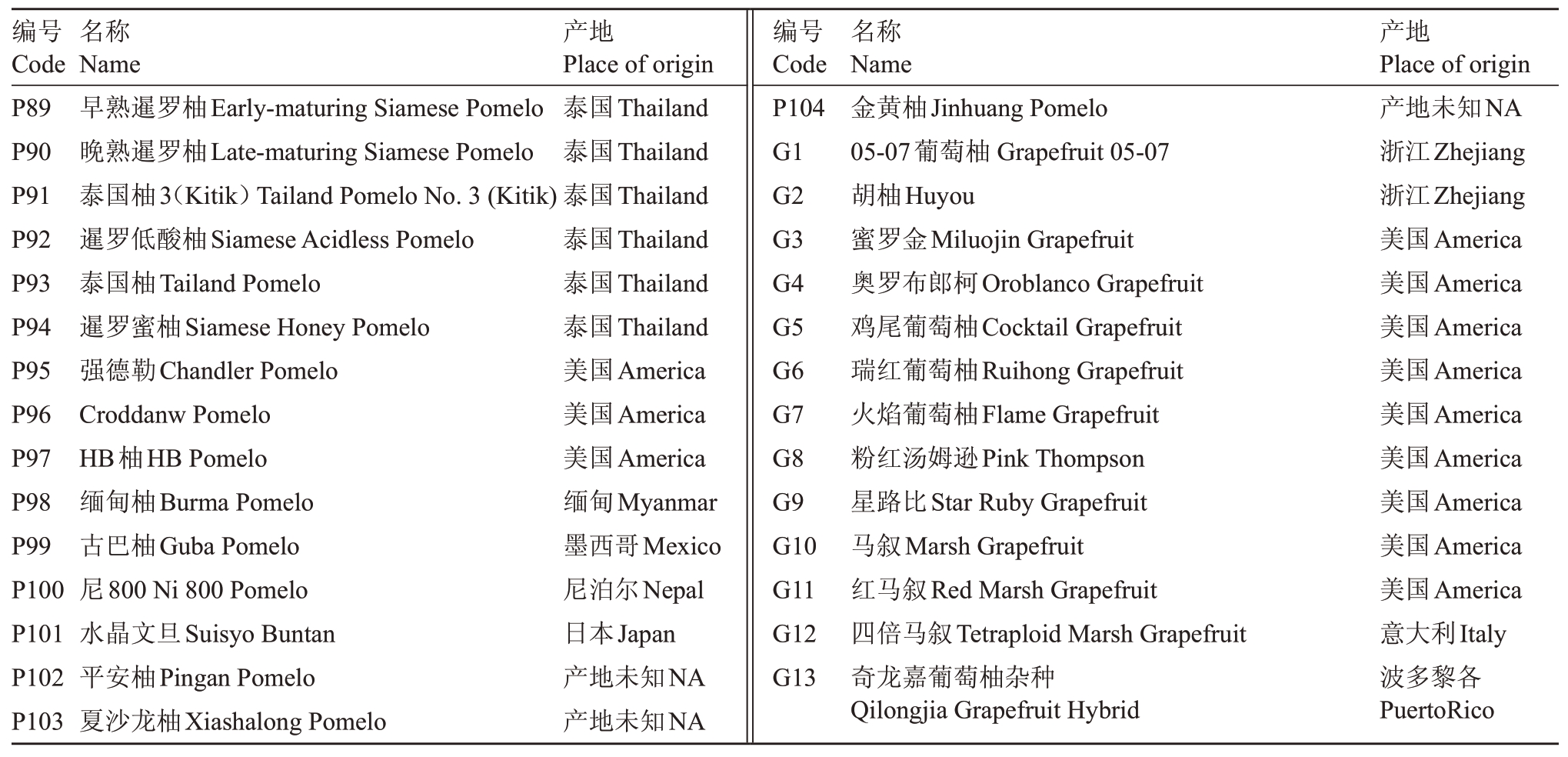
注:编号P 开头为柚品种资源,G 开头为葡萄柚品种资源。
Note:The number beginning with the letter P is pomelo resources;The number beginning with the letter G is grapefruit resources.
编号Code名称Name产地Place of origin编号Code名称Name产地Place of origin P89 P90 P91 P92 P93 P94 P95 P96 P97 P98 P99 P100 P101 P102 P103早熟暹罗柚Early-maturing Siamese Pomelo晚熟暹罗柚Late-maturing Siamese Pomelo泰国柚3(Kitik)Tailand Pomelo No.3(Kitik)暹罗低酸柚Siamese Acidless Pomelo泰国柚Tailand Pomelo暹罗蜜柚Siamese Honey Pomelo强德勒Chandler Pomelo Croddanw Pomelo HB柚HB Pomelo缅甸柚Burma Pomelo古巴柚Guba Pomelo尼800 Ni 800 Pomelo水晶文旦Suisyo Buntan平安柚Pingan Pomelo夏沙龙柚Xiashalong Pomelo泰国Thailand泰国Thailand泰国Thailand泰国Thailand泰国Thailand泰国Thailand美国America美国America美国America缅甸Myanmar墨西哥Mexico尼泊尔Nepal日本Japan产地未知NA产地未知NA P104 G1 G2 G3 G4 G5 G6 G7 G8 G9 G10 G11 G12 G13金黄柚Jinhuang Pomelo 05-07葡萄柚Grapefruit 05-07胡柚Huyou蜜罗金Miluojin Grapefruit奥罗布郎柯Oroblanco Grapefruit鸡尾葡萄柚Cocktail Grapefruit瑞红葡萄柚Ruihong Grapefruit火焰葡萄柚Flame Grapefruit粉红汤姆逊Pink Thompson星路比Star Ruby Grapefruit马叙Marsh Grapefruit红马叙Red Marsh Grapefruit四倍马叙Tetraploid Marsh Grapefruit奇龙嘉葡萄柚杂种Qilongjia Grapefruit Hybrid产地未知NA浙江Zhejiang浙江Zhejiang美国America美国America美国America美国America美国America美国America美国America美国America美国America意大利Italy波多黎各PuertoRico
1.2 数据采集方法
DUS 测试中数量性状表达可通过目测或测量的方法观测。当品种内变异较小时,通常可以通过目测而减少工作量;而当品种间差异较小,目测无法判定该性状是否存在明显差异,或当对一个通常采用目测的数量性状作为与另一品种相区别的性状没把握时,应对该数量性状进行测量,通过统计分析的方法判定[11]。
对柑橘属测试指南中的25 个数量性状采集田间数据,其中18个为测量性状,7个为群体目测性状(T1、T2、T10、T11、T16、T17、T20)。为提升性状观测的精准性,调查时均采用测量的方法,以测量值对个体或群体进行记录(表2)。
表2 研究中观测的25 个数量性状
Table 2 25 quantitative characteristics investigated in this study
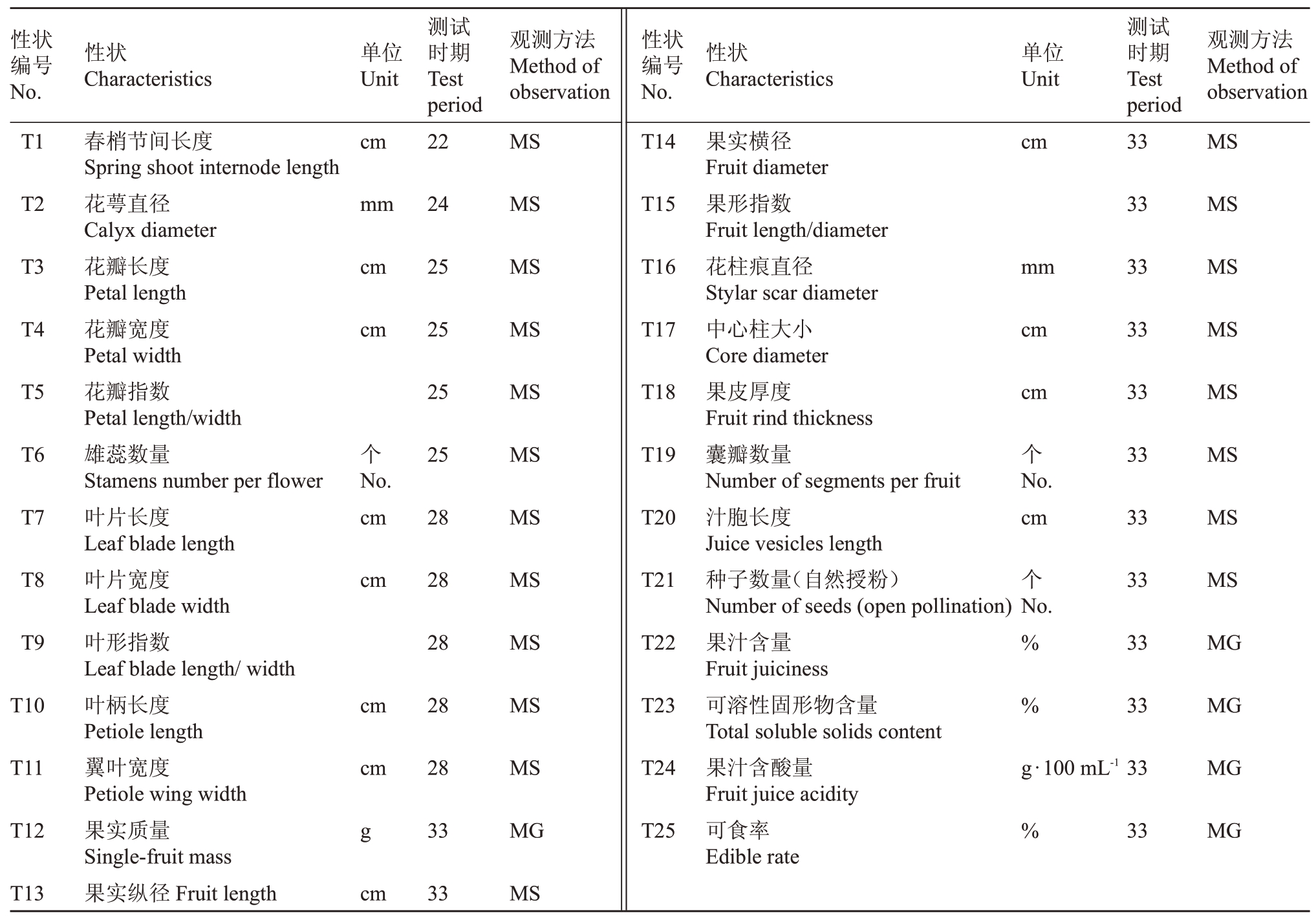
注:测试时期中22 代表春梢自剪期,24 代表初花期,25 代表盛花期,28 代表第二次生理落果期,33 代表果实成熟期。观测方法,MS 为个体测量,对1 批个体或个体的某器官或部位进行逐个测量,获得1 组个体记录;MG 为群体测量,对1 批个体或个体的某器官或部位进行测量,获得1 个群体记录。
Note:In test period,22 represents the self-pruning period of spring shoots,24 represents the initial flowering period,25 represents the full flowering period,28 represents the second physiological fruit drop period,and 33 represents the fruit maturity period.Method of observation,MS is individual measurement.One group of individual records is obtained by measuring one batch of individuals or one organ or part of individuals one by one;MG is group measurement.One group of individual records is obtained by measuring one batch of individuals or one organ or part of individuals.
性状编号No.T1性状Characteristics单位Unit性状Characteristics单位Unit测试时期Test period 22 cm观测方法Method of observation MS性状编号No.T14 cm测试时期Test period 33观测方法Method of observation MS T2 mm 24 MS T15 33 MS T3 cm 25 MS T16 mm 33 MS T4 cm 25 MS T17 cm 33 MS T5 25 MS T18 cm 33 MS T6个25 MS T19个33 MS T7 No.cm 28 MS T20 No.cm 33 MS T8 cm 28 MS T21个33 MS T9 MS 28 T22 33果实横径Fruit diameter果形指数Fruit length/diameter花柱痕直径Stylar scar diameter中心柱大小Core diameter果皮厚度Fruit rind thickness囊瓣数量Number of segments per fruit汁胞长度Juice vesicles length种子数量(自然授粉)Number of seeds(open pollination)果汁含量Fruit juiciness可溶性固形物含量Total soluble solids content果汁含酸量Fruit juice acidity可食率Edible rate MG T10 No.cm 28 MS T23%%33 MG T11 cm 28 MS T24 g·100 mL-1 33 MG T12 g 33 MG T25%33 MG T13春梢节间长度Spring shoot internode length花萼直径Calyx diameter花瓣长度Petal length花瓣宽度Petal width花瓣指数Petal length/width雄蕊数量Stamens number per flower叶片长度Leaf blade length叶片宽度Leaf blade width叶形指数Leaf blade length/width叶柄长度Petiole length翼叶宽度Petiole wing width果实质量Single-fruit mass果实纵径Fruit length cm 33 MS
1.3 数据处理与分析
利用Microsoft Excel 2021计算出各性状的最小值、最大值、中值、平均值和标准差。根据公式(1)计算品种内变异系数CV1,根据公式(2)计算品种间变异系数CV2。其中X1为每个性状每个品种的均值,X2为各性状的均值,S1为每个性状每个品种的标准差,S2为各性状的标准差。

遗传多样性指数采用香农多样性指数,计算公式为H’=-∑Pi×ln(Pi) ,其中Pi 表示某个性状第i个代码出现的概率,H’为遗传多样性指数。使用SPSS软件进行K-S检验及LSD检验,通过Origin软件绘制频率分布直方图和Q-Q 图,利用R 语言进行相关性分析并作图。
2 结果与分析
2.1 柚类种质资源数量性状变异情况分析
性状表达状态在品种内变异系数越小,该性状在品种内表达越稳定;在品种间变异系数越大,遗传背景越丰富,利用该性状鉴别品种的可能性越大。对117 份柚类种质资源的数量性状进行统计分析(表3),结果表明,25个数量性状的品种内变异系数介于2.96%~26.96%之间,其中T23可溶性固形物含量、T14 果实横径和T15 果形指数的品种内变异系数较小,分别为2.96%、3.40%和3.86%,说明这几个性状在品种内的稳定性较好;T11翼叶宽度和T21种子数量的品种内变异系数较大,分别为23.01%和26.96%,表明这2个性状在品种内的稳定性较差,易受环境等因素影响。
表3 25 个数量性状数据的变异分析
Table 3 Variation analysis of 25 quantitative characteristics
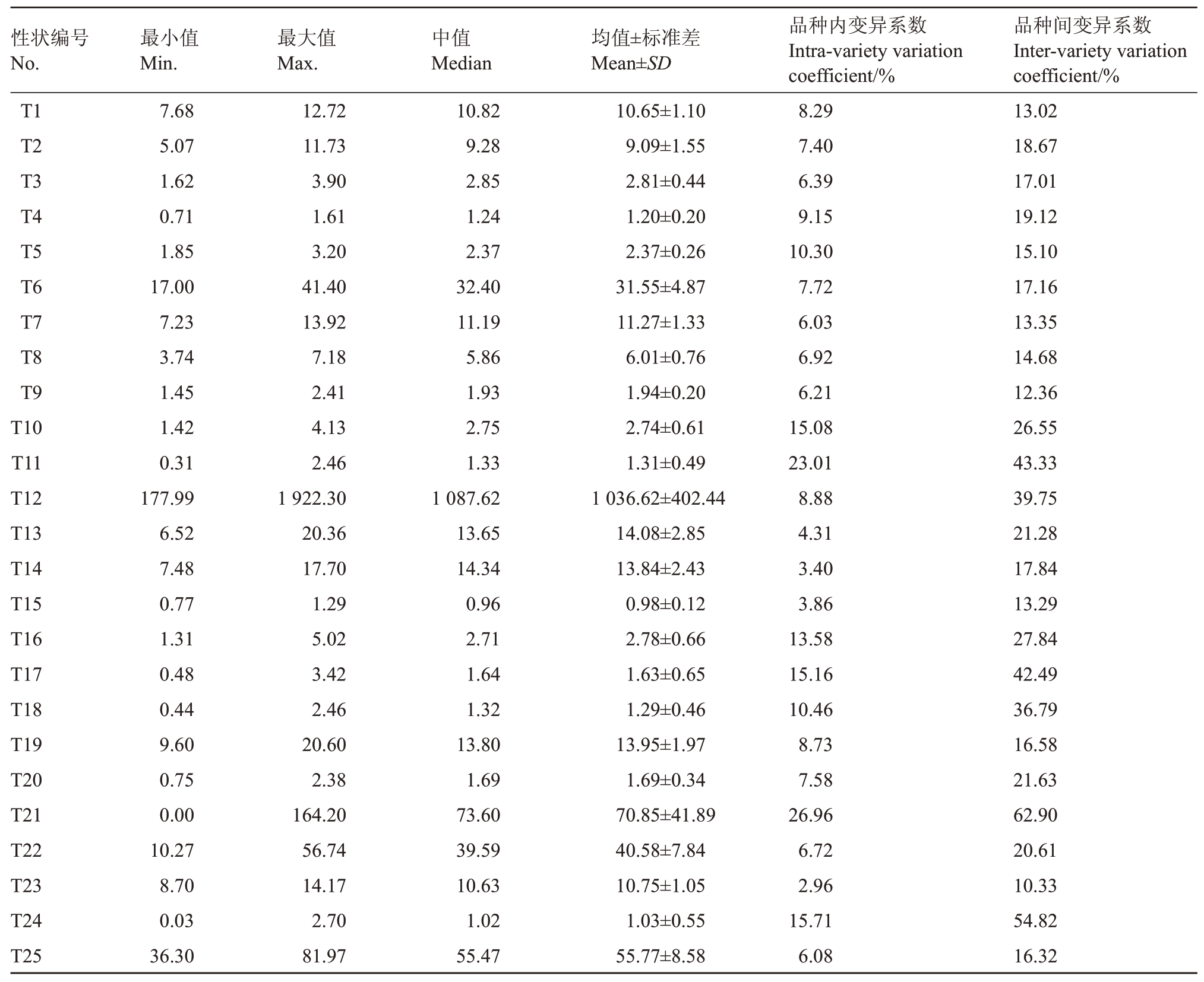
性状编号No.T1 T2 T3 T4 T5 T6 T7 T8 T9 T10 T11 T12 T13 T14 T15 T16 T17 T18 T19 T20 T21 T22 T23 T24 T25最小值Min.7.68 5.07 1.62 0.71 1.85 17.00 7.23 3.74 1.45 1.42 0.31 177.99 6.52 7.48 0.77 1.31 0.48 0.44 9.60 0.75 0.00 10.27 8.70 0.03 36.30最大值Max.12.72 11.73 3.90 1.61 3.20 41.40 13.92 7.18 2.41 4.13 2.46 1 922.30 20.36 17.70 1.29 5.02 3.42 2.46 20.60 2.38 164.20 56.74 14.17 2.70 81.97中值Median 10.82 9.28 2.85 1.24 2.37 32.40 11.19 5.86 1.93 2.75 1.33 1 087.62 13.65 14.34 0.96 2.71 1.64 1.32 13.80 1.69 73.60 39.59 10.63 1.02 55.47均值±标准差Mean±SD 10.65±1.10 9.09±1.55 2.81±0.44 1.20±0.20 2.37±0.26 31.55±4.87 11.27±1.33 6.01±0.76 1.94±0.20 2.74±0.61 1.31±0.49 1 036.62±402.44 14.08±2.85 13.84±2.43 0.98±0.12 2.78±0.66 1.63±0.65 1.29±0.46 13.95±1.97 1.69±0.34 70.85±41.89 40.58±7.84 10.75±1.05 1.03±0.55 55.77±8.58品种内变异系数Intra-variety variation coefficient/%8.29 7.40 6.39 9.15 10.30 7.72 6.03 6.92 6.21 15.08 23.01 8.88 4.31 3.40 3.86 13.58 15.16 10.46 8.73 7.58 26.96 6.72 2.96 15.71 6.08品种间变异系数Inter-variety variation coefficient/%13.02 18.67 17.01 19.12 15.10 17.16 13.35 14.68 12.36 26.55 43.33 39.75 21.28 17.84 13.29 27.84 42.49 36.79 16.58 21.63 62.90 20.61 10.33 54.82 16.32
所有数量性状的品种间变异系数均大于品种内变异系数,变化范围在10.33%~62.90%之间。品种间变异系数较大的有T11 翼叶宽度(43.33%)、T12果实质量(39.75%)、T17 中心柱大小(42.49%)、T18果皮厚度(36.79%)、T21 种子数量(62.90%)和T24果汁含酸量(54.82%),这些性状在品种间的变异幅度大,遗传变异较为丰富。
2.2 柚类种质资源数量性状正态性检验
数量性状分级方法的选择与性状表达状态是否符合正态分布密切相关,对各数量性状的数据进行K-S 正态性检验并绘制频率分布直方图和Q-Q 图(表4,图1)。T3 花瓣长度、T5 花瓣指数、T7 叶片长度、T9 叶形指数、T10 叶柄长度、T11 翼叶宽度、T16花柱痕直径、T17中心柱大小、T18果皮厚度、T19囊瓣数量、T21种子数量、T22果汁含量、T23可溶性固形物含量、T24 果汁含酸量以及T25 可食率这15 个性状的K-S 检验p 值大于0.05,中值与平均值接近,数据分布较均匀,Q-Q 图中实测值与预测正态值偏差不大,符合正态分布;T1春梢节间长度、T4花瓣宽度、T6雄蕊数量及T8叶片宽度这4个性状的K-S检验p 值小于0.05,但其频次分布曲线与正态分布曲线较为相似,偏度与峰度值均小于1,Q-Q图中实测值与预测正态值偏差不大,可认为符合近似正态分布;T2 花萼直径、T13 果实纵径、T14 果实横径、T15果形指数、T20汁胞长度这5个性状的K-S检验p值小于0.05,中值与平均值差距较大,频率分布直方图可看出对称性较差且Q-Q图中实测值与预测正态值偏差较大,不符合正态分布;T12果实质量的K-S检验p值虽大于0.05,但中值与均值相差较大,数据分布不均匀,同时其Q-Q 图中实测值与预测正态值也具有偏差,故认为不符合正态分布。
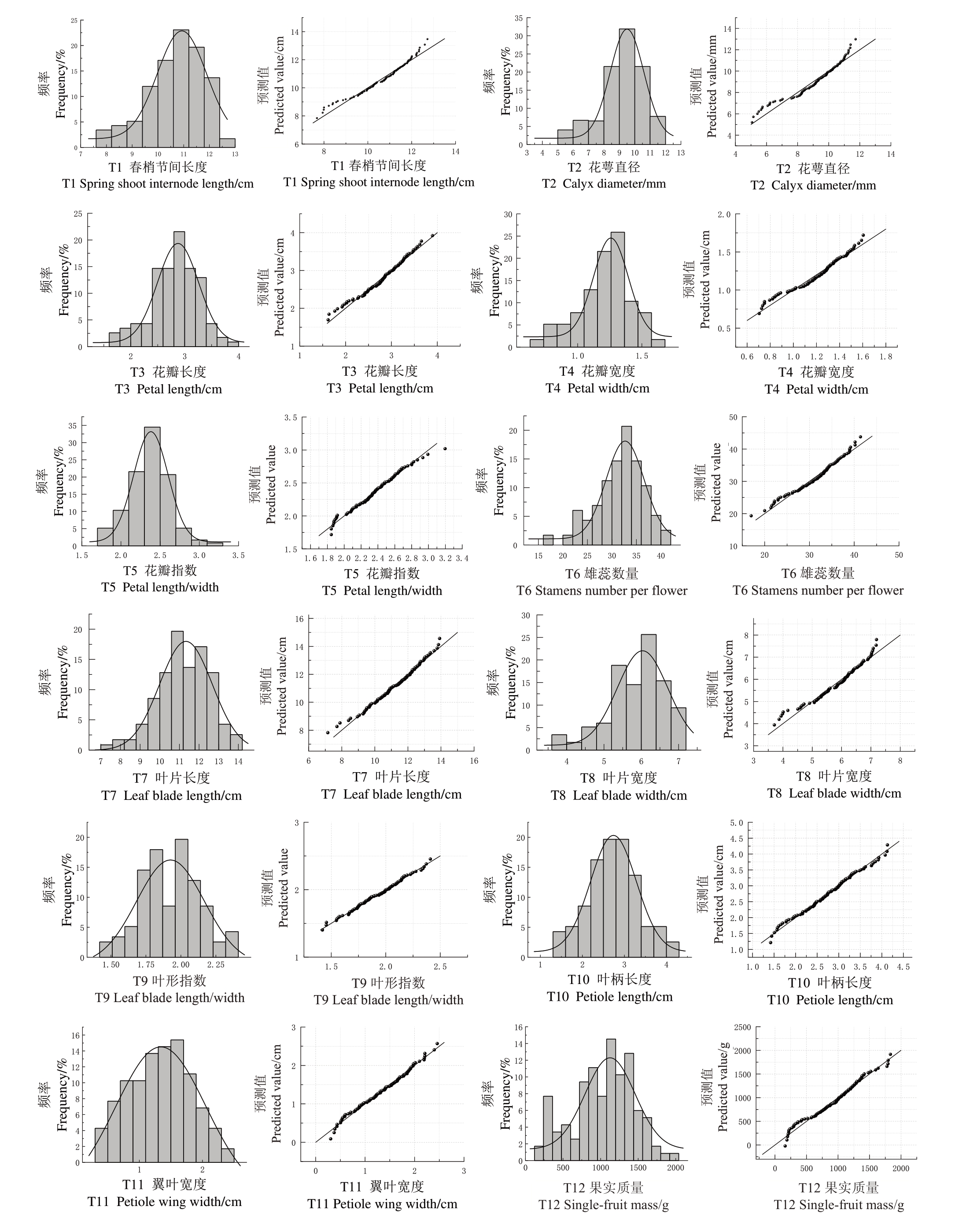
图1 25 个数量性状的频率分布图和Q-Q 图
Fig.1 Frequency distribution of 25 quantitative characteristics and Q-Q testing
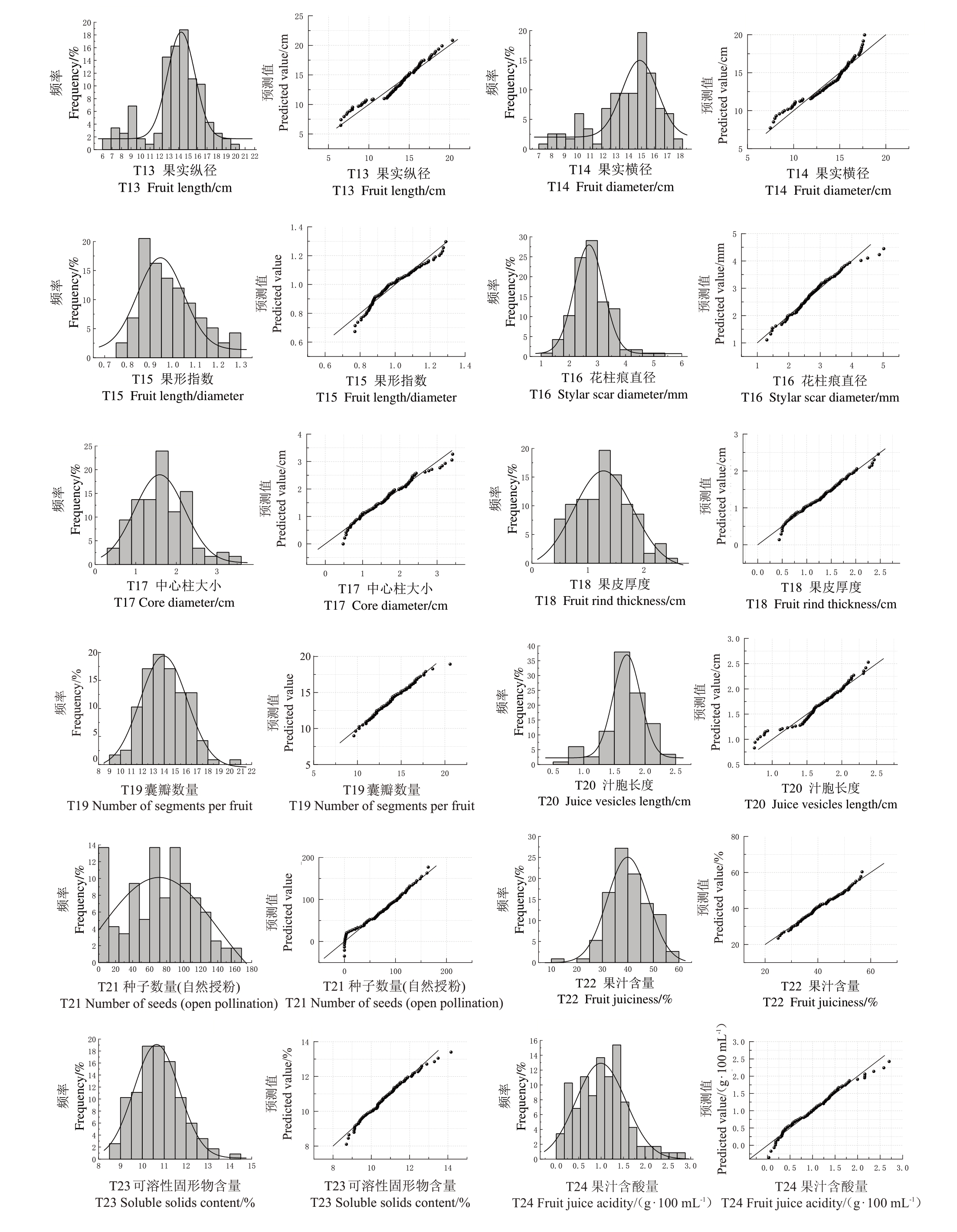
图1 (续) Fig.1 (Continued)
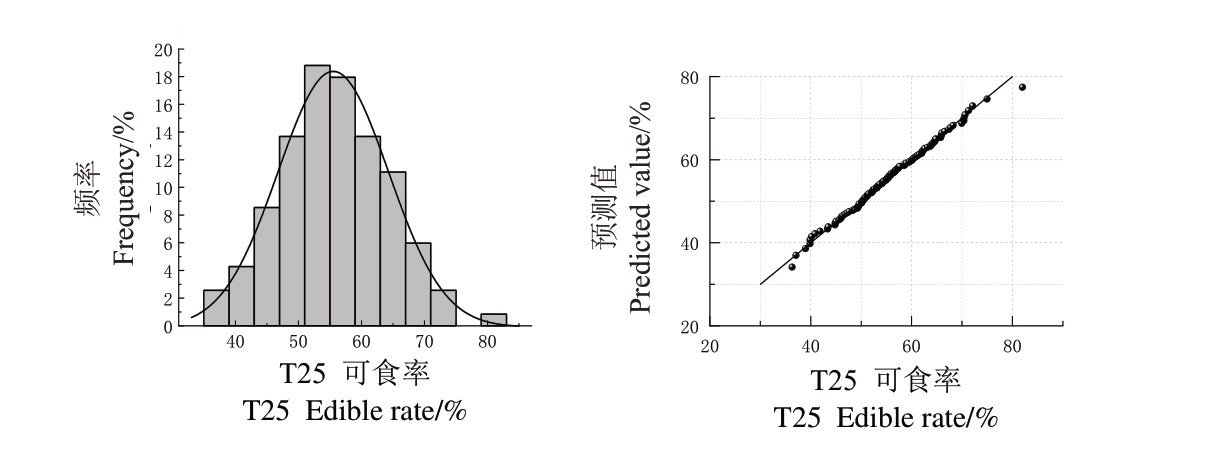
图1 (续) Fig.1 (Continued)
表4 数量性状K-S 检验
Table 4 K-S normal test of the quantitative characteristics
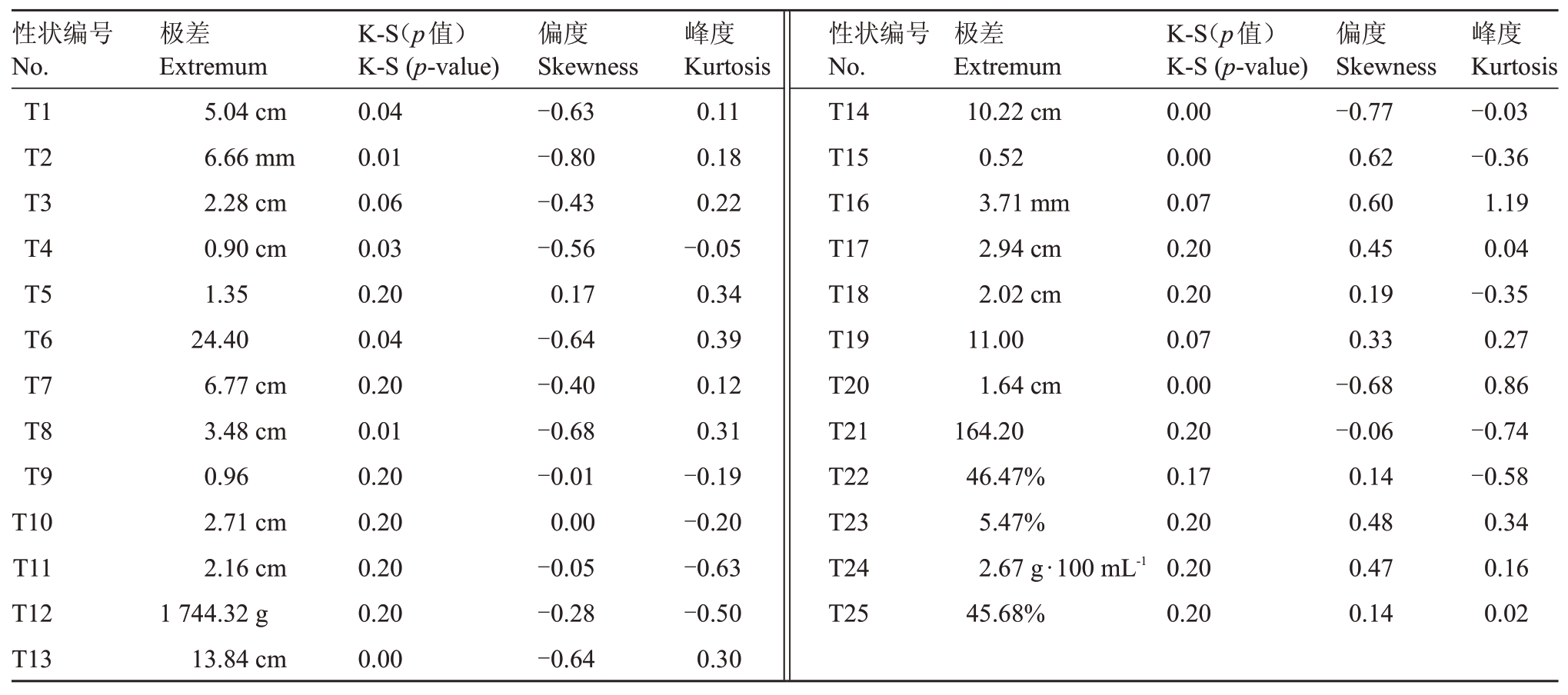
性状编号No.T1 T2 T3 T4 T5 T6 T7 T8 T9 T10 T11 T12 T13极差Extremum 5.04 cm 6.66 mm 2.28 cm 0.90 cm 1.35 24.40 6.77 cm 3.48 cm 0.96 2.71 cm 2.16 cm 1 744.32 g 13.84 cm K-S(p值)K-S(p-value)0.04 0.01 0.06 0.03 0.20 0.04 0.20 0.01 0.20 0.20 0.20 0.20 0.00偏度Skewness-0.63-0.80-0.43-0.56 0.17-0.64-0.40-0.68-0.01 0.00-0.05-0.28-0.64峰度Kurtosis 0.11 0.18 0.22-0.05 0.34 0.39 0.12 0.31-0.19-0.20-0.63-0.50 0.30性状编号No.T14 T15 T16 T17 T18 T19 T20 T21 T22 T23 T24 T25极差Extremum 10.22 cm 0.52 3.71 mm 2.94 cm 2.02 cm 11.00 1.64 cm 164.20 46.47%5.47%2.67 g·100 mL-1 45.68%K-S(p值)K-S(p-value)0.00 0.00 0.07 0.20 0.20 0.07 0.00 0.20 0.17 0.20 0.20 0.20偏度Skewness-0.77 0.62 0.60 0.45 0.19 0.33-0.68-0.06 0.14 0.48 0.47 0.14峰度Kurtosis-0.03-0.36 1.19 0.04-0.35 0.27 0.86-0.74-0.58 0.34 0.16 0.02
在不符合正态分布的6个性状中,发现3个性状的频率分布图呈现出明显的双峰分布,这些性状分别是T12 果实质量、T13 果实纵径和T14 果实横径。进一步分析发现,这种双峰现象主要由葡萄柚和柚两个种之间的显著差异所引起。葡萄柚属于小型果而柚属于大型果,两者在这3 个的性状上表现出较大的差异,从而导致双峰分布的情况。因此若将柚和葡萄柚在这些数量性状上进行统一分级,会导致分级范围宽而将有差异的品种错判为无差异,进而增加错误发生的概率。将针对这3个性状分别为柚和葡萄柚制定不同的分级标准,并以“编号1(仅适用于柚)”、“编号2(仅适用于葡萄柚)”的形式呈现。
上述3个性状在柚和葡萄柚群体中的分布情况及其K-S检验如图2、表5所示。对两类群数据进行分离处理后,发现除柚群体在性状T14 的数据不符合正态分布外,其余基本符合正态分布或近似正态分布。

图2 果实质量、果实纵径和果实横径在柚和葡萄柚群体中的分布情况
Fig.2 Distribution of single-fruit mass,fruit length and fruit diameter in pomelo and grapefruit populations
表5 基于柚和葡萄柚群体数据的3 个数量性状K-S 检验
Table 5 K-S test of three quantitative characteristics based on population data of pomelo and grapefruit

性状编号No.T12 T13 T14柚Pomelo K-S(p值)K-S(p-value)0.200 0.121 0.016偏度Skewness-0.084-0.067-0.497峰度Kurtosis-0.209 0.689-0.087葡萄柚Grapefruit K-S(p值)K-S(p-value)0.200 0.200 0.200偏度Skewness 0.406 0.240 0.016峰度Kurtosis-0.885-0.859-0.761
2.3 柚类种质资源数量性状分级和多样性分析
在DUS测试中,对符合正态分布的数量性状分级使用较多的是概率分布法和最小显著差法。概率分布法按(X-1.281 8S)、(X-0.524 6S)、(X+0.524 6S)和(X+1.281 8S)4个分点可将性状分为3或5级(X为均值、S 为标准差);最小差异显著法通过计算每个数量性状的LSD0.05的值,以测量数据的中值为中心,级差大于等于2 倍LSD0.05向两侧进行等距划分,再通过实际情况对每个区间进行调整,可将数量性状分为3~9 级不等。国际植物新品种保护联盟(简称UPOV)提出每个分级所包含的区间不得小于2 倍LSD0.05[12],不仅确保了每个相邻分级之间具有明显的差异,而且能将相对集中的数据进行较为细致的划分。
大多性状利用概率分布法的分级区间不满足大于等于2 倍LSD0.05的要求,且有较多的品种资源落在两端代码的范围,不利于区分特殊的(如极大或者极小)品种,故对符合正态分布和近似正态分布的性状均采用最小显著差法进行分级。对于不符合正态分布的数量性状,运用极差法来进行划分。首先通过极差与分级数的比值计算出每一个数量性状的分级级差,以分布范围的中位数为分级中点,按公式y=G±(1/2+n)x(n=0、1、2、3、4,G为数据中位数,x为分级级差)进行级别划分,确定各数量性状分级区间。根据性状的变异、数据分布情况以及田间的整体表现情况来确定分级数(表6)。
表6 25 个数量性状的分级范围和分布频率
Table 6 Grading range and frequency for 25 quantitative characteristics

试数测级属分橘南柑指Number of grades in the testing guidelines of Citrus 33999399933933究数研级本分Number of grades in this study 3577537753395757 0.0%9>2 051.0>3.80 0.9%0.0%0.0%0.0%1 760.0~2 015.0 2.9%1.9%0.0%8>1.66>14.35>7.65>19.00>18.60 2.6%6.0%10.3%3.4%6.0%8.5%5.0%9.6%15.4%17.20~19.00 7.7%7.7%8.7%7>11.50>3.40~3.80>1.46~1.66>2.84>13.10~14.35>6.90~7.65>2.30>1 505.0~1 760.0>468.0>9.56>17.00~18.60 24.8%35.3%27.6%35.0%23.9%22.2%27.4%29.9%23.1%23.9%28.2%25.0%7.7%21.2%23.1%22.1%6>11.40>9.75~11.50>3.00~3.40>1.26~1.46>2.52~2.84>35.00>11.85~13.10>6.15~6.90>2.05~2.30>3.15>1.65>1 250.0~1 505.0>373.0~468.0>15.40~17.20>8.46~9.56>15.40~17.00 9.80~11.40 54.5%44.8%35.3%33.3%47.0%28.30~35.00 53.8%35.9%36.8%45.5%2.35~3.15 51.3%1.05~1.65 41.9%26.0%30.8%34.6%38.5%34.6%5>8.00~9.75>2.60~3.00>1.06~1.26>2.20~2.52>10.60~11.85>5.40~6.15>1.80~2.05>995.0~1250.0>278.0~373.0>13.60~15.40>7.36~8.46>13.80~15.40 20.7%6.25~8.00 8.6%19.8%11.1%1.88~2.20 20.5%23.9%23.1%16.2%1.55~1.80 23.1%24.0%183.0~278.0 38.5%27.9%6.26~7.36 30.8%23.1%4≤9.80>2.20~2.60>0.86~1.06≤28.30>9.35~10.60>4.65~5.40≤2.3524.8%≤1.0529.9%>740.0~995.0>11.80~13.60>12.20~13.80 1.80~2.20 8.6%7.8%0.66~0.86 9.4%5.1%8.10~9.35 5.1%3.90~4.65 6.8%3.3%8.7%7.7%10.00~11.80 1.9%0.0%10.60~12.20 7.7%3≤6.25≤1.88≤1.55>485.0~740.0≤183.0≤6.26分Grading and frequency率频布分2.6%0.9%2.6%1.7%230.0~485.0 3.8%4.8%3.8%及2≤1.80≤0.66≤8.10≤3.90≤10.00≤10.60围范级1≤230.0 0.0%号编,No.性No.状T1/cm T2/mm T3/cm T4/cm T5T6/个T7/cm T8/cm T9T10/cm T11/cm T12.1/g T12.2/g T13.1/cm T13.2/cm T14.1/cm
表6 (续) Table 6(Continued)

试数测级属分橘南柑指Number of grades in the testing guidelines of Citrus 33999359993究数研级本分Number of grades in this study 553575555593 9>2.15 2.6%3.4%4.3%8>2.20>1.85~2.15>10.80 7.7%4.8%6.0%5.1%0.9%4.3%5.1%0.9%3.4%9.4%7>1.24>2.70>1.85~2.20>19.00>2.15>137.00>56.60>12.80>1.55~1.85 25.0%23.1%18.8%22.2%24.8%18.8%29.9%26.5%26.5%19.7%20.5%24.8%6>9.60~10.80>1.07~1.24>3.32>2.00~2.70>1.50~1.85>15.65~19.00>1.80~2.15>93.00~137.00>45.20~56.50>11.40~12.80>1.25~1.55>62.00>8.60~9.70 30.8%>0.90~1.07 46.2%65.8%40.2%28.2%57.3%49.6%36.8%51.3%37.6%19.7%49.00~62.00 56.4%5>2.22~3.32>1.30~2.00>1.15~1.50>12.30~15.65>1.45~1.80>49.00~93.00>33.80~45.20>10.00~11.40>0.95~1.25 7.50~8.60 30.8%0.73~0.90 24.0%15.4%0.60~1.30 27.4%19.7%8.95~12.30 23.1%1.10~1.45 8.5%5.00~49.00 19.7%22.40~33.80 17.9%8.60~10.00 39.3%16.2%18.8%4≤2.22>0.80~1.15>0.65~0.95≤49.00 7.7%≤0.73≤7.50 0.0%4.3%0.45~0.80 17.1%0.0%7.7%12.0%3.4%0.0%15.4%3≤0.60≤8.95≤1.10≤5.00≤22.40≤8.60>0.35~0.65分Grading and frequency率频布分0.9%0.05~0.35 12.0%及2≤0.45围范级1≤0.05 0.9%号编,No.,No.性No.状T14.2/cm T15 T16/mm T17/cm T18/cm T19/个T20/cm T21/个T22/%T23/%T24/(g·100 mL-1)T25/%
通过最小差异显著法和极差法,将性状T1春梢节间长度、T6 雄蕊数量、T10 叶柄长度、T11 翼叶宽度、T16花柱痕直径和T25可食率分成3个连续分布的分级范围,性状T2 花萼直径、T5 花瓣指数、T9 叶形指数、T12.2果实质量(仅适用于葡萄柚)、T13.2果实纵径(仅适用于葡萄柚)、T14.2果实横径(仅适用于葡萄柚)、T15 果形指数、T17 中心柱大小、T19 囊瓣数量、T20 汁胞长度、T21 种子数量(自然授粉)、T22 果汁含量和T23 可溶性固形物含量分成5 个连续分布的分级范围,性状T3 花瓣长度、T4 花瓣宽度、T7叶片长度、T8叶片宽度、T13.1果实纵径(仅适用于柚)、T14.1 果实横径(仅适用于柚)和T18 果皮厚度分成7个连续分布的分级范围,性状T12.1果实质量(仅适用于柚)和T24果汁含酸量分成9个连续分布的分级范围。
25 个性状的区间均大于2 倍的LSD0.05,符合UPOV对相邻分级间明显差异的要求。将分级数与柑橘属测试指南的分级数相比(表6),T2花萼直径、T15 果形指数、T20 汁胞长度由3 级增为5 级;T3 花瓣长度、T4 花瓣宽度、T7 叶片长度、T8 叶片宽度、T18果皮厚度由9级减为7级;T5花瓣指数、T9叶形指数、T17 中心柱大小、T19 囊瓣数量、T22 果汁含量、T23可溶性固形物含量由9级减为5级。对于性状T12 果实质量、T13 果实纵径和T14 果实横径,中国柑橘属测试指南中分为了9级、3级、3级,笔者在本研究中针对柚类种质资源的分布特点,单独划分了柚和葡萄柚的分级范围,这3个性状对柚划分为9级、7级、7级,对葡萄柚均划分为5级,此分级范围更适用于中国柚类的DUS测试。
利用分布频率计算的25 个数量性状的遗传多样性指数H’在0.878~1.954 之间变化(表7),均值为1.318,遗传多样性指数H’从高到低依次为:T24>T12.1>T18>T14.1>T3>T13.1>T8>T7>T4>T14.2>T21>T12.2>T17>T9>T5>T13.2>T20>T2>T23>T15>T22>T11>T10>T19>T6>T1>T25>T16。T24 果汁含酸量、T12.1 果实质量(仅适用于柚)、T18 果实横径等性状的多样性指数相对较大,表明这些性状的表现型较多且在不同等级中均匀分布。
表7 25 个数量性状的多样性指数
Table 7 Shannon’s index of 25 quantitative characteristics
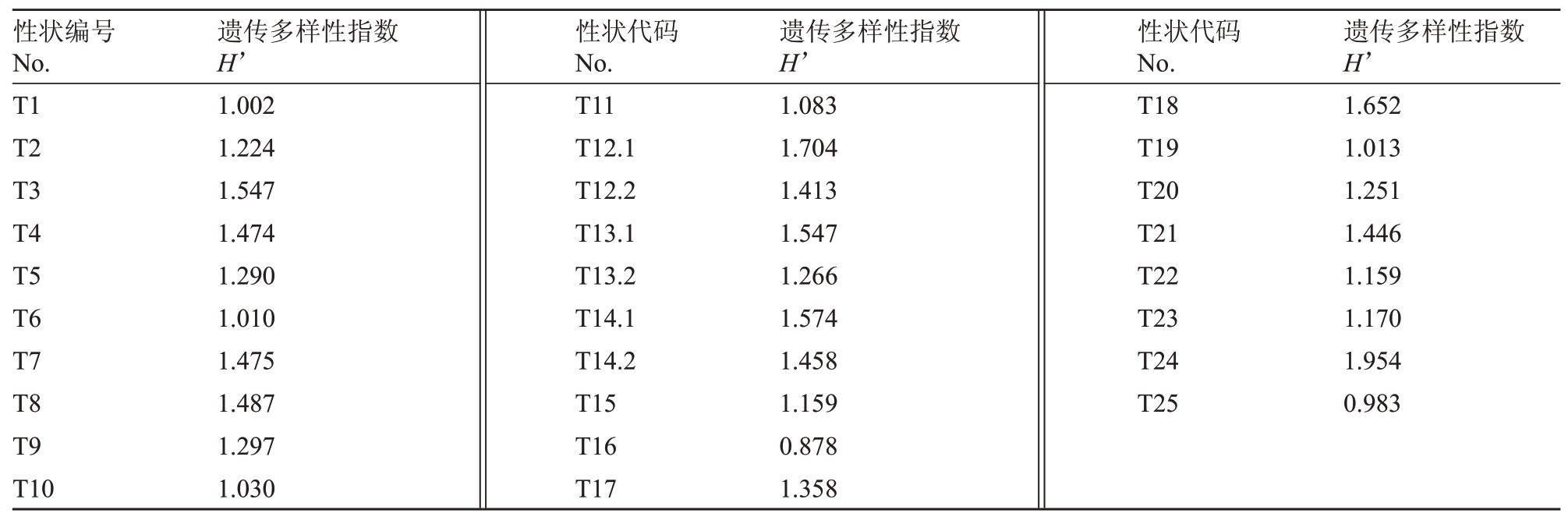
性状编号No.T1 T2 T3 T4 T5 T6 T7 T8 T9 T10遗传多样性指数H’1.002 1.224 1.547 1.474 1.290 1.010 1.475 1.487 1.297 1.030性状代码No.T11 T12.1 T12.2 T13.1 T13.2 T14.1 T14.2 T15 T16 T17遗传多样性指数H’1.083 1.704 1.413 1.547 1.266 1.574 1.458 1.159 0.878 1.358性状代码No.T18 T19 T20 T21 T22 T23 T24 T25遗传多样性指数H’1.652 1.013 1.251 1.446 1.159 1.170 1.954 0.983
2.4 柚类种质资源数量性状相关性分析
为了排除种间差异带来的影响,除去葡萄柚品种资源单独绘制104个柚品种资源在25个数量性状之间的相关性热图(图3)。多个性状之间存在不同程度相关性,相关系数分布在-0.69~0.91 之间,花、叶、果内部间包含的性状相关性高。5 个花性状间的相关系数绝对值在0.25~0.73之间,平均相关系数绝对值为0.46,T2花萼直径与T3花瓣长度、T4花瓣宽度、T6 雄蕊数量存在极显著正相关关系(0.59、0.73、0.47);T4 花瓣宽度与T3 花瓣长度、T6 雄蕊数量呈极显著正相关(0.66、0.50),与T5花瓣指数呈极显著负相关(-0.48)。5个叶性状间的相关系数绝对值在0.03~0.82 之间,平均0.33,T10 叶柄长度与T11翼叶宽度呈极显著正相关(0.82);T7叶片长度与T8叶片宽度、T9叶形指数和T10叶柄长度呈极显著正相关(0.47、0.44、0.31);T8 叶片宽度与T9 叶形指数呈极显著负相关(-0.58)。14个果实性状间的相关系数绝对值在0.00~0.91之间,平均0.22,T14果实横径与T12果实质量的相关系数最大,为0.91,呈极显著正相关;T22果汁含量与T25可食率呈极显著正相关(相关系数为0.76);T13 果实纵径与T14 果实横径、T15果形指数和T18果皮厚度呈极显著正相关(0.60、0.55、0.47)。另外,T18果皮厚度还与T22果汁含量、T25可食率呈极显著负相关(-0.69、-0.67),表明果皮越厚,果汁含量和可食率越低。不同类型的性状也存在着一定的相关性,比如T2 花萼直径、T3 花瓣长度、T4 花瓣宽度与T9 叶形指数呈极显著负相关(-0.43、-0.43、-0.30)、与T8叶片宽度呈极显著正相关(0.47、0.45、0.35);T12 果实质量、T13 果实纵径、T14果实横径与T2花萼直径、T3花瓣长度、T4花瓣宽度、T6 雄蕊数量、T8 叶片宽度也均呈极显著正相关。
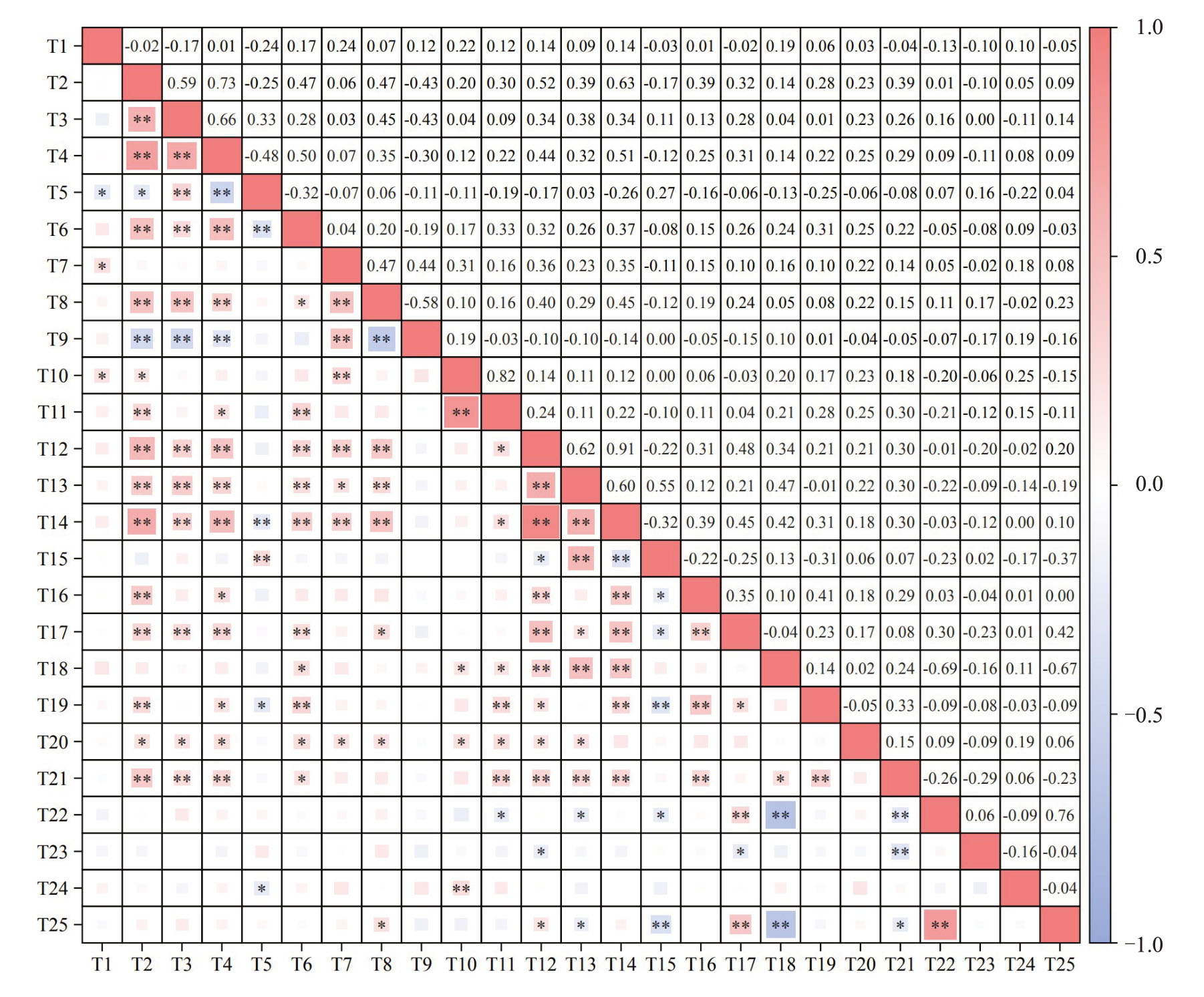
图3 25 个数量性状相关性热图
Fig.3 Correlation heat map of 25 quantitative characteristics
*表示显著相关,**表示极显著相关。
*indicates significant correlation,**indicates extremely significant correlation.
2.5 数量性状主成分分析
利用SPSS 将25 个数量性状进行主成分分析,以特征值大于等于1 为标准,共提取出6 个主成分(表8),累积贡献率达72.76%,表明这25 个数量性状的遗传信息可由这6个主成分代表。第一个主成分特征值为7.57,贡献率为30.27%,包含着最多的信息,主要由果实横径、果实质量、果实纵径、花瓣宽度、花萼直径、花瓣长度、中心柱大小、雄蕊数量、汁胞长度、叶片宽度和种子数量这11 个性状决定;第二个主成分特征值为2.99,贡献率为11.98%,包含可食率、果汁含量和果皮厚度3个性状,主要是与果实的食用性相关的性状;第三个主成分的特征值为2.60,贡献率为10.40%,包含叶柄长度、翼叶宽度、叶片长度和春梢节间长度4 个性状,主要与叶片大小和春梢节间长度相关;第四个主成分的特征值为2.00,贡献率为7.98%,包含囊瓣数量、花柱痕直径、果形指数和花瓣指数4 个性状,为果心以及长宽比相关性状;第五个主成分的特征值为1.61,贡献率为6.45%,包含叶形指数1 个性状;第六个主成分的特征值为1.42,贡献率为5.67%,包含可溶性固形物含量和果汁含酸量2个性状,为果实品质相关性状。
表8 主成分分析特征值、贡献率和累积贡献率
Table 8 Principal component analysis of eigenvalue,contribution rate and cumulative contribution rate

成分Component 123456特征值Characteristic value 7.57 2.99 2.60 2.00 1.61 1.42贡献率Contribution rate/%30.27 11.98 10.40 7.98 6.45 5.67累积贡献率Cumulative contribution rate/%30.27 42.25 52.65 60.63 67.09 72.76
3 讨论
变异系数是衡量数据离散程度的重要指标,不仅能够评估单一数据集内的变异性,还能够跨数据集进行变异程度的比较。在本研究中,25个数量性状中果实质量和果汁含酸量在品种内的稳定性较好,其变异系数分别为8.88%和15.71%,同时在品种间表现出较丰富的遗传多样性,变异系数分别为39.75%和54.82%,说明这两个性状在描述和区分品种时具有较高的实用价值和应用潜力。种子数量和翼叶宽度的品种间变异系数分别达62.90%和43.33%,尽管这两个性状在品种间存在较大的遗传变异,但两者的品种内变异系数也较大,分别为26.96%和23.01%,反映这两个性状在品种内的稳定性较差,因此在对种子数量和翼叶宽度进行测试时,需要考虑环境条件等因素以确保测试结果的准确性和可靠性。
DUS 测试数量性状的合理分级是特异性判定的重要环节,也是制定、修订测试指南最重要和最关键的部分[13]。为方便测试数据信息化处理,以及消除同一品种在不同年度、不同测试地点间同一性状表达数据不同造成的差异,在DUS测试中需要将性状表达状态实际测量值转化为以数字表示的分级代码。数量性状分级过少,每一级可能导致性状表达状态有差异的两个品种代码相同,增加错误概率;分级过多,不仅无法排除品种内差异、校正测量误差,还可能错将两个相似品种判定为有差异,导致误判[14]。数量性状的分级有极差法、概率分级法、中值平均标准差法以及最小显著差法等多种。极差法又称等距法,此方法简单直观,在向日葵[15]、毛花猕猴桃[16]等数量性状的分级中得以应用;概率分级法依据数据的分布规律进行分级,适用于正态分布的性状,该方法在枣[17]、草莓[18]、大花惠兰[19]、杜仲[20]等数量性状的分级中均有应用,能较准确地反映性状的变异范围和分布状态,但通常只能将数量性状分为3级或5级[21],并且对于数据分布比较集中的性状会存在分级区间过小的情况,使之不满足UPOV 对数量性状的基本要求(分级级差不得小于2 倍LSD0.05);褚云霞等[22]和纪军建等[13]利用中值平均标准差法进行数量性状分级,此法操作简便,但若数据呈偏态分布,仅依靠平均值和标准差进行分级可能会导致分级不够精细或不够准确;最小显著差法适用于符合正态分布的性状,能够检测出较小的差异,即使在性状数据相近时也能区分出显著性差异,同时灵活性强,可将性状分为3~9级不等,目前已经广泛应用于多种植物的数量性状分级[23-25]。不同的分级方法有各自的适用范围和局限性,分级方法的选择需考虑测试目标、性状的分布特征以及测试指南的要求。笔者在本研究中根据柚类种质的调查数据,将25 个数量性状进行正态性检验,对符合正态分布的性状采用最小显著差法,对不符合正态分布的性状选用极差法,同时结合田间表现情况及未来育种发展的可能性,对25个数量性状的分级进行调整,最终各性状的分级区间均符合大于等于2 倍LSD0.05的基本要求。由于数量性状的表达易受到栽培环境和气候条件的影响,本研究中的分级标准以重庆地区柚类的生长情况为基础,具体分级范围可能不完全适用于其他生态区域。确定的25 个数量性状表达状态划分可作为参考,在测试过程中研究者需根据标准品种的表达状态并结合田间情况做出相应的调整,确保能够准确地评估和比较不同区域内品种的性状差异。
由于数量性状的表达易受到栽培环境和气候条件的影响,同一品种在不同年度或区域间的表现可能会有所变化[26]。因此即便UPOV发布了相应的测试指南,也需要针对各国家和地区的具体条件进行调整,以确保分级标准的实用性[27]。UPOV 作为国际指南,对数量性状的分级大多采用最大尺度(1~9级尺度),各成员国可结合本国的具体情况对其进行修改。笔者在本研究中针对柚类种质资源,对中国柑橘属测试指南中的数量性状重新进行划分,与中国柑橘属测试指南相比:花萼直径、果形指数、汁胞长度由3 级增为5 级,花瓣长度、花瓣宽度、叶片长度、叶片宽度、果皮厚度由9级减为7级,花瓣指数、叶形指数、中心柱大小、囊瓣数量、果汁含量、可溶性固形物含量由9 级减为5 级。与UPOV 发布的柚类测试指南(TG/204/1)相比:花瓣长度、花瓣宽度、叶片长度、叶片宽度、果皮厚度由9级减为了7级;花萼直径、花瓣指数、果形指数、中心柱大小、囊瓣数量、汁胞长度、果汁含量、可溶性固形物含量、种子数量(自然授粉)由9级减为了5级;叶柄长度、翼叶宽度、花柱痕直径由9级减为了3级。而对于果实质量、果实纵径和果实横径,笔者在本研究中发现这3 个性状在柚类材料的频率分布图中呈明显的双峰型分布,且这种分布情况是由柚和葡萄柚的种间差异造成的。中国柑橘属测试指南和UPOV柚类测试指南(TG/204/1)均没有在这3 个性状上对两者进行区分,笔者在本研究中通过对两年的测量数据分级发现,若两个种一起分级会导致分级区间范围过大,可能会使两个有差异的品种代码相同,增加测试的错误概率,不利于两种类型品种的区分[14]。玉米测试中存在着类似的情况,自交系玉米在植株高度、穗位高度和果穗长度等性状上会明显低于杂交种玉米,对此玉米DUS 测试指南(GB/T 19557.24—2018)在这些性状上进行划分,对不同类型品种分别制定了分级标准和标准品种。同样棉花DUS 测试指南(NY/T 2238—2012)也采用了相同的方法,在6个数量性状上对陆地棉和海岛棉两个种分类分级。柚与葡萄柚虽同为柚类,在较多性状上有着相似之处,使得两者可同用一本测试指南进行测试,但在体型的大小上却存在较大的区别。因此笔者在本研究中参照玉米DUS 测试指南的处理方法,分别在果实质量、果实纵径和果实横径3 个性状上制定了柚和葡萄柚的分级标准。该分级范围更适用于中国柚类的区分和鉴别,增强了对柚类品种鉴定的准确性,为柚类DUS 测试的准确性和科学性提供理论基础和参考。
柑橘属含有宽皮柑橘、甜橙、柠檬、柚等几十个种,这些种亲缘关系较近,但在形态上却差异巨大。目前中国柑橘属的DUS测试仅有《植物新品种特异性、一致性和稳定性测试指南柑橘》(NY/T 2435—2013)一个测试指南可依,采用同一个指南作为测试标准可能会对性状表达状态的判断产生偏差。例如柑橘属指南中“果实:果脐”、“果实:乳突”在柚类中就鲜有表达。国际植物新品种保护联盟(UPOV)已将柑橘属分为了宽皮柑橘、橙、柠檬和来檬、柚和葡萄柚等不同组,每组都有其特定的测试指南,可以更精确地反映不同品种间的差异。因此,为更好地开展柚类品种测试工作,服务广大育种者和生产者,使中国柚类品种的DUS 测试工作有其特有的标准可依,确保植物品种DUS 测试数据的准确性和权威性,应当结合国际测试指南,有针对性地制定适合中国柚类品种鉴定及保护的DUS测试指南,从而更精准地为柚类品种DUS测试服务。
4 结论
依据《植物新品种特异性、一致性和稳定性测试指南柑橘》对25 个数量性状数据进行了分级研究,确定了各数量性状的分级范围,对柚类DUS测试数量性状描述分级具有较好的指导作用,并可对下一步修订柑橘属DUS测试指南提供参考。
[1] 张太平,彭少麟.柚的起源、演化及分布初探[J].生态学杂志,2000,19(5):58-61.ZHANG Taiping,PENG Shaolin. Introduction to the origin and evolution of pomelo and its distribution in China[J]. Chinese Journal of Ecology,2000,19(5):58-61.
[2] 郭林榕,陈文光,熊月明.葡萄柚的产销及发展前景[J].福建果树,2002(3):34-35.GUO Linrong,CHEN Wenguang,XIONG Yueming. Grapefruit production, marketing and development prospects[J]. Fujian Fruits,2002(3):34-35.
[3] BARRETT H C,RHODES A M.A numerical taxonomic study of affinity relationships in cultivated citrus and its close relatives[J].Systematic Botany,1976,1(2):105.
[4] 钟广炎,叶荫民.柑橘植物的数值分类学研究[J].植物分类学报,1993,31(3):252-260.ZHONG Guangyan,YE Yinmin. A numerical taxonomy study of Citrus and its close relatives[J]. Acta Phytotaxonomica Sinica,1993,31(3):252-260.
[5] LI X M,XIE R J,LU Z H,ZHOU Z Q.The origin of cultivated citrus as inferred from internal transcribed spacer and chloroplast DNA sequence and amplified fragment length polymorphism fingerprints[J].Journal of the American Society for Horticultural Science,2010,135(4):341-350.
[6] 彭良志. 柚类产业发展现状与发展对策[J]. 中国果业信息,2008(6):8-11.PENG Liangzhi. Development status and development countermeasures of pomelo industry[J]. China Fruit News,2008(6):8-11.
[7] 张太平,彭少麟,王峥峰,陈碧琛.柚类种质资源研究与保护概况[J].生态科学,2001,20(3):8-13.ZHANG Taiping,PENG Shaolin,WANG Zhengfeng,CHEN Bichen. Introduction to the study and protection of pomelo germplasm[J].Ecologic Science,2001,20(3):8-13.
[8] 胡安华,窦万福,祁静静,雷天刚,陈善春,邹修平,彭爱红,许兰珍,姚利晓,何永睿,李强.柚类种质资源表型多样性分析及综合评价[J].分子植物育种,2020,18(2):650-664.HU Anhua,DOU Wanfu,QI Jingjing,LEI Tiangang,CHEN Shanchun,ZOU Xiuping,PENG Aihong,XU Lanzhen,YAO Lixiao,HE Yongrui,LI Qiang. Phenotypic diversity analysis and comprehensive evaluation of pomelo germplasms[J].Molecular Plant Breeding,2020,18(2):650-664.
[9] 汪奇.我国柚品种(系)选育分析及海南柚种质资源收集、鉴定与初步评价[D].海口:海南大学,2021.WANG Qi. Breeding analysis of pomelo varieties (lines) in China and collection,identification and preliminary evaluation of pomelo germplasm resources in Hainan[D]. Haikou:Hainan University,2021.
[10] 褚云霞,陈海荣,邓姗,黄志城,李寿国.中外植物新品种保护DUS 审查方式之比较与借鉴[J].种子,2016,35(6):70-74.CHU Yunxia,CHEN Hairong,DENG Shan,HUANG Zhicheng,LI Shouguo.The comparison and revelation on the DUS testing methods of protection of plant new varieties among China and foreign countries[J].Seed,2016,35(6):70-74.
[11] 唐浩.植物品种特异性、一致性、稳定性测试总论[M].北京:中国农业出版社,2017:25-28.TANG Hao. General introduction to plant variety distinctness,uniformity and stability testing[M]. Beijing:China Agriculture Press,2017:25-28.
[12] UPOV. Document TGP/8/1 Use of statistical procedures in distinctness,uniformity and stability testing[S].2002.
[13] 纪军建,付国庆,寇淑君,王瑶,左振兴,杨德智,刘晓婕,霍阿红.谷子新品种DUS 测试数量性状分级及遗传多样性研究[J].种子,2022,41(9):17-27.JI Junjian,FU Guoqing,KOU Shujun,WANG Yao,ZUO Zhenxing,YANG Dezhi,LIU Xiaojie,HUO Ahong.Quantitative character classification and genetic diversity of new millet varieties based on DUS testing[J].Seed,2022,41(9):17-27.
[14] 郭晓亮,王红娟,段媛媛,阮芝艳.重齿当归形态数量性状的分级研究[J].热带亚热带植物学报,2021,29(6):688-693.GUO Xiaoliang,WANG Hongjuan,DUAN Yuanyuan,RUAN Zhiyan. Classification study on morphological quantitative characteristics of Angelica biserrata[J]. Journal of Tropical and Subtropical Botany,2021,29(6):688-693.
[15] 王永行,单飞彪,白立华,杜瑞霞,杨钦方,刘春晖. 向日葵DUS 测试主要数量性状的变异及概率分布研究[J]. 作物研究,2019,33(1):26-28.WANG Yongxing,SHAN Feibiao,BAI Lihua,DU Ruixia,YANG Qinfang,LIU Chunhui. Variation and distribution of main quantitative characters of sunflower in DUS testing[J].Crop Research,2019,33(1):26-28.
[16] 郎彬彬,朱博,谢敏,张文标,SEYREK U A,黄春辉,徐小彪.野生毛花猕猴桃种质资源主要数量性状变异分析及评价指标探讨[J].果树学报,2016,33(1):8-15.LANG Binbin,ZHU Bo,XIE Min,ZHANG Wenbiao,SEYREK U A,HUANG Chunhui,XU Xiaobiao.Variation and probability grading of the main quantitative characteristics of wild Actinidia eriantha germplasm resources[J]. Journal of Fruit Science,2016,33(1):8-15.
[17] 刘孟军.枣树数量性状的概率分级研究[J].园艺学报,1996,23(2):105-109.LIU Mengjun.Studies on the variations and probability gradings of major quantitative characters of Chinese jujube[J].Acta Horticulturae Sinica,1996,23(2):105-109.
[18] 杨雷,杨莉,李莉,孙立祎,郝保春.草莓种质资源果实主要数量性状变异及概率分级[J].西南农业学报,2007,20(5):1067-1069.YANG Lei,YANG Li,LI Li,SUN Liyi,HAO Baochun. Variation and probability grading of main quantitative characters of fruit in strawberry germplasm resource[J]. Southwest China Journal of Agricultural Sciences,2007,20(5):1067-1069.
[19] 张韶伊,宁惠娟,范义荣.大花蕙兰主要数量性状的变异及概率分级[J].浙江农业科学,2013,54(9):1118-1121.ZHANG Shaoyi,NING Huijuan,FAN Yirong. Variation and probability grading of the main quantitative traits of C. grandiflora[J]. Journal of Zhejiang Agricultural Sciences,2013,54(9):1118-1121.
[20] 杜庆鑫,庆军,王璐,刘攀峰,何凤,朱利利,杜红岩.杜仲种质资源果实主要数量性状变异及概率分级[J].植物研究,2019,39(3):387-394.DU Qingxin,QING Jun,WANG Lu,LIU Panfeng,HE Feng,ZHU Lili,DU Hongyan. Variation and probability grading of main quantitative traits of fruits for Eucommia ulmoides germplasm[J].Bulletin of Botanical Research,2019,39(3):387-394.
[21] 王红娟,蒋晓英,官玲,唐荣莉,白文钦,林清.南方春大豆品种DUS 测试数量性状表达状态分级[J].分子植物育种,2023,21(3):1015-1025.WANG Hongjuan,JIANG Xiaoying,GUAN Ling,TANG Rongli,BAI Wenqin,LIN Qing. Grading of DUS testing quantitative characteristics of southern spring soybean varieties[J]. Molecular Plant Breeding,2023,21(3):1015-1025.
[22] 褚云霞,邓姗,黄志城,顾晓君,李寿国,张永春,陈海荣.朱顶红新品种DUS 测试数量性状筛选与分级[J].植物遗传资源学报,2016,17(3):466-474.CHU Yunxia,DENG Shan,HUANG Zhicheng,GU Xiaojun,LI Shouguo,ZHANG Yongchun,CHEN Hairong. Selection and classification for Amaryllis(Hippeastrum)DUS testing quantitative traits[J]. Journal of Plant Genetic Resources,2016,17(3):466-474.
[23] 李娟,孔德章,焦爱霞,周欢欢,韦启迪,张丽娜,霍可以.基于贵州地区玉米DUS 测试数量性状变异与分级标准研究[J].种子,2021,40(10):34-40.LI Juan,KONG Dezhang,JIAO Aixia,ZHOU Huanhuan,WEI Qidi,ZHANG Lina,HUO Keyi.Study on quantitative trait variation and grading standard of maize by DUS test in Guizhou region[J].Seed,2021,40(10):34-40.
[24] 方超,唐轩,胡桂兵,刘洪,马强,陈孟强,饶得花,徐振江.荔枝DUS 测试数量性状分级研究[J].果树学报,2020,37(5):635-644.FANG Chao,TANG Xuan,HU Guibing,LIU Hong,MA Qiang,CHEN Mengqiang,RAO Dehua,XU Zhenjiang. A study on grading of quantitative characteristics of litchi[J]. Journal of Fruit Science,2020,37(5):635-644.
[25] 徐丽,高玲,刘迪发,张如莲,刘维侠.黄秋葵DUS 测试主要数量性状的测量及分级[J].中国蔬菜,2017(12):51-56.XU Li,GAO Ling,LIU Difa,ZHANG Rulian,LIU Weixia.Measuring and grading of major quantitative traits of okra DUS test[J].China Vegetables,2017(12):51-56.
[26] 唐浩,刘洪,余汉勇,张浙峰,肖应辉,杨益善,陈立云. 基于DUS 测试的标准品种形态性状稳定性和重要性分析[J].作物学报,2013,39(4):632-641.TANG Hao,LIU Hong,YU Hanyong,ZHANG Zhefeng,XIAO Yinghui,YANG Yishan,CHEN Liyun. Stability and importance of morphological characteristics in example varieties based on DUS test[J].Acta Agronomica Sinica,2013,39(4):632-641.
[27] 陈宇华,陈剑锋,钟声远,钟海丰,刘中华.金鱼草DUS 测试数量性状分析与分组性状判定[J].福建农业学报,2023,38(8):944-952.CHEN Yuhua,CHEN Jianfeng,ZHONG Shengyuan,ZHONG Haifeng,LIU Zhonghua. DUS traits and classification of Antirrhinum majus L.[J]. Fujian Journal of Agricultural Sciences,2023,38(8):944-952.